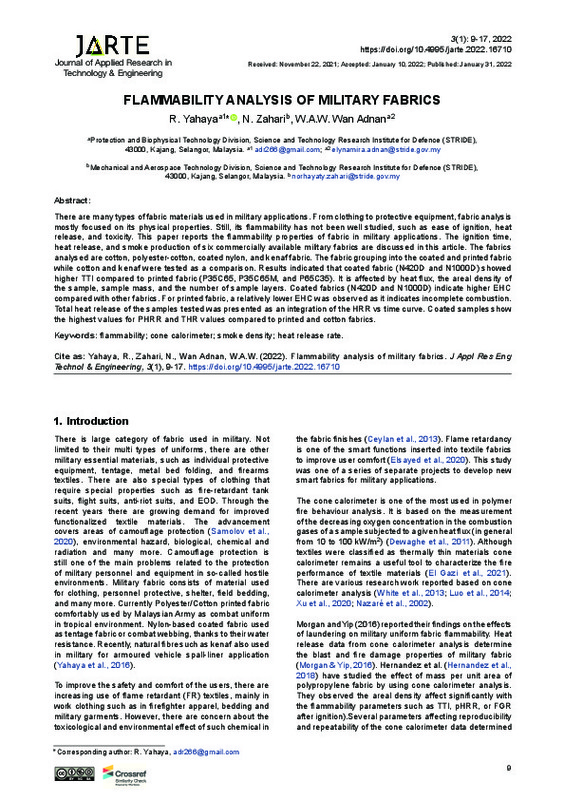Alongi, J., Tata, J., Carosio, F., Rosace, G., Frache, A., & Camino, G. (2015). A Comparative Analysis of Nanoparticle Adsorption as Fire-Protection Approach for Fabrics. Polymers, 7(1), 47-68. https://doi.org/10.3390/polym7010047
Babrauskas, V., & Peacock, R. D. (1992). Heat Release Rate: The Single Most Important Variable in Fire Hazard. Fire Safety Journal, 18, 255-272. https://doi.org/10.1016/0379-7112(92)90019-9
Bei, P., Liwei, C., & Chang, L. (2012). International Symposium on Safety Science and Engineering in China, An Experimental Study on the Burning Behavior of Fabric used Indoor. 43, 257-261. https://doi.org/10.1016/j.proeng.2012.08.044
[+]
Alongi, J., Tata, J., Carosio, F., Rosace, G., Frache, A., & Camino, G. (2015). A Comparative Analysis of Nanoparticle Adsorption as Fire-Protection Approach for Fabrics. Polymers, 7(1), 47-68. https://doi.org/10.3390/polym7010047
Babrauskas, V., & Peacock, R. D. (1992). Heat Release Rate: The Single Most Important Variable in Fire Hazard. Fire Safety Journal, 18, 255-272. https://doi.org/10.1016/0379-7112(92)90019-9
Bei, P., Liwei, C., & Chang, L. (2012). International Symposium on Safety Science and Engineering in China, An Experimental Study on the Burning Behavior of Fabric used Indoor. 43, 257-261. https://doi.org/10.1016/j.proeng.2012.08.044
Ceylan, Ö., Alongi, J., Landuyt, L. Van, Frache, A., & Clerck, K. De. (2013). Combustion characteristics of cellulosic loose fibres. Fire and Materials, 37, 482-490. https://doi.org/10.1002/fam.2147
Chee, S. S., Jawaid, M., Alothman, O. Y., & Yahaya, R. (2020). Thermo-oxidative stability and flammability properties of bamboo/kenaf/nanoclay/epoxy hybrid nanocomposites. RSC Advances, 10(37), 21686-21697. https://doi.org/10.1039/d0ra02126a
Chen, Q., & Zhao, T. (2016). The thermal decomposition and heat release properties of the nylon/cotton, polyester/cotton and Nomex/cotton blend fabrics. Textile Research Journal, 86(17), 1859-1868. https://doi.org/10.1177/0040517515617423
Dewaghe, C., Lew, C. Y., Claes, M., Belgium, S. A., & Dubois, P. (2011). Fire-retardant applications of polymer-carbon nanotubes composites: Improved barrier effect and synergism. In Polymer-Carbon Nanotube Composites: Preparation, Properties and Applications. Woodhead Publishing Limited. 718-745. https://doi.org/10.1533/9780857091390.3.718
El Gazi, M., Sonnier, R., Giraud, S., Batistella, M., Basak, S., Dumazert, L., Hajj, R., & El Hage, R. (2021). Fire behavior of thermally thin materials in cone calorimeter. Polymers, 13(8). https://doi.org/10.3390/polym13081297
Elsayed, E. M., Attia, N. F., & Alshehri, L. A. (2020). Innovative Flame Retardant and Antibacterial Fabrics Coating Based on Inorganic Nanotubes. Chemistry Select, 5(10), 2961-2965. https://doi.org/10.1002/slct.201904182
Fateh, T., Kahanji, C., Joseph, P., & Rogaume, T. (2017). A study of the effect of thickness on the thermal degradation and flammability characteristics of some composite materials using a cone calorimeter. Journal of Fire Sciences, 35(6), 547-564. https://doi.org/10.1177/0734904117713690
Godfrey, T., Auerbach, M., Proulx, G., Yip, P., & Grady, M. (2016). Modeling exposures of a nylon-cotton fabric to high radiant heat flux. Journal of Engineered Fibers and Fabrics, 11(3), 55-63. https://doi.org/10.1177/155892501601100308
Grover, T., Khandual, A., & Luximon, A. (2014). Fire protection: Flammability and textile fibres. Colourage, 61(5), 39-45+48.
Hernandez, N., Sonnier, R., & Giraud, S. (2018). Influence of grammage on heat release rate of polypropylene fabrics. Journal of Fire Sciences, 36(1), 30-46. https://doi.org/10.1177/0734904117738928
Huggett, C. (1980). Estimation of rate of heat release by means of oxygen consumption measurements. Fire and Materials, 4(2), 61-65. https://doi.org/10.1002/fam.810040202
Kotresh, T. M., Indushekar, R., Subbulakshmi, M. S., Vijayalakshmi, S. N., Prasad, A. K., & Agrawal, A. K (2006). Evaluation of Commercial Flame Retardant Polyester Curtain Fabrics in the Cone Calorimeter. Journal of Industrial Textiles, 36, 47-58. https://doi.org/10.1177/1528083706064379
Luo, S. L., Zhang, H. L., Zhan, Z. C., Mao, B. H., Jiang, Z. J., & Yan, Y. R. (2014). Investigation of flammable behavior of nylon 6 fabrics with and without spandex using cone calorimeter test and vertical burning test. Advanced Materials Research, 852, 644-647. https://doi.org/10.4028/www.scientific.net/AMR.852.644
Moinuddin, K., Razzaque, Q. S., & Thomas, A. (2020). Numerical simulation of coupled pyrolysis and combustion reactions with directly measured fire properties. Polymers, 12(9), 2075. https://doi.org/10.3390/POLYM12092075
Morgan, A. B., & Yip, P. W. (2016). Effects of laundering on military uniform fabric flammability. Fire and Materials, 40, 599-611. https://doi.org/10.1002/fam.2313
Mouritz, A. P., Mathys, Z., & Gibson, A. G. (2006). Heat release of polymer composites in fire. Composites Part A: Applied Science and Manufacturing, 37(7), 1040-1054. https://doi.org/10.1016/j.compositesa.2005.01.030
Nazaré, S., Kandola, B., & Horrocks, A. R. (2002). Use of cone calorimetry to quantify the burning hazard of apparel fabrics. Fire and Materials, 26(4-5), 191-199. https://doi.org/10.1002/fam.796
Samolov, A. D., Simić, D. M., Fidanovski, B. Z., Obradović, V. M., Tomić, L. D., & Knežević, D. M. (2020). Improvement of VIS and IR camouflage properties by impregnating cotton fabric with PVB/IF-WS2. Defence Technology, 17(6), 2050-2056. https://doi.org/10.1016/j.dt.2020.10.008
Tata, J., Alongi, J., Carosio, F., & Frache, A. (2011). Optimization of the procedure to burn textile fabrics by cone calorimeter: Part I.Combustion behavior of polyester. Fire and Materials, 35(6) 397-409. https://doi.org/10.1002/fam.1061
White, R.H., Nam, S., Parikh, D.V. (2013). Cone calorimeter evaluation of two flame retardant cotton fabrics. Fire and Materials, 37, 46-57. https://doi.org/10.1002/fam.2111
Xu, D., Wang, S., Wang, Y., Liu, Y., Dong, C., Jiang, Z., & Zhu, P. (2020). Preparation and mechanism of flameretardant cotton fabric with phosphoramidate siloxane polymer through multistep coating. Polymers, 12(7), 1538. https://doi.org/10.3390/polym12071538
Xu, Q., Chen, L., Harries, K. A., & Li, X. (2017). Combustion performance of engineered bamboo from cone calorimeter tests. European Journal of Wood and Wood Products, 75(2), 161-173. https://doi.org/10.1007/s00107-016-1074-6
Yahaya, R., Sapuan, S., Jawaid, M., Leman, Z., & Zainudin, E. (2014). Mechanical performance of woven kenafKevlar hybrid composites. Journal of Reinforced Plastics and Composites, 33, 2242-2254. https://doi.org/10.1177/0731684414559864
Yahaya, R., Sapuan, S. M., Jawaid, M., Leman, Z., & Zainudin, E. S. (2016). Effect of fibre orientations on the mechanical properties of kenaf-aramid hybrid composites for spall-liner application. Defence Technology, 12(1), 52-58. https://doi.org/10.1016/j.dt.2015.08.005
Yang, C .Q., & He, Q. (2011). Applications of micro-scale combustion calorimetry to the studies of cotton and nylon fabrics treated with organophosphorus flame retardants. Journal of Analytical and Applied Pyrolysis, 91(1), 125-133. https://doi.org/10.1016/j.jaap.2011.01.012
[-]









